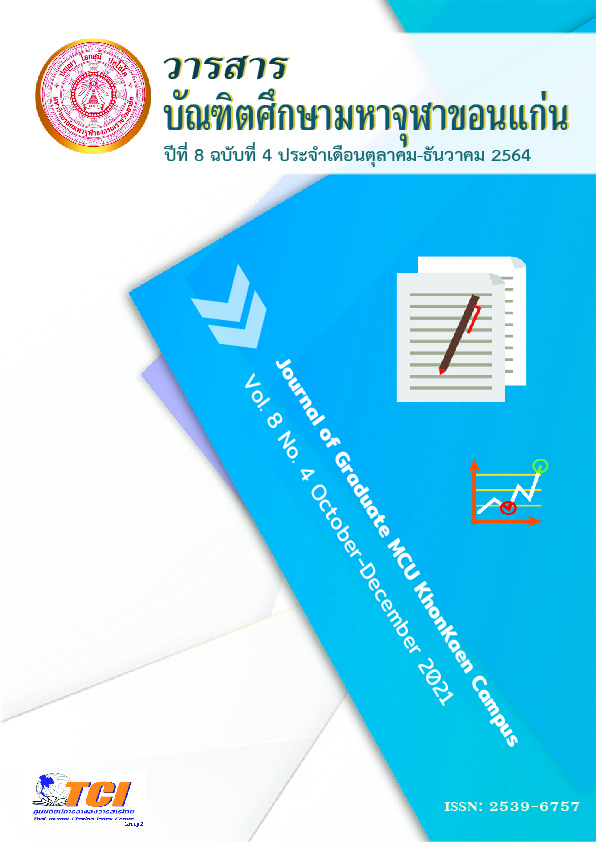STUDY OF THE PRACTICES OF THAI WOMEN IN THE MYTHS OF BEAUTY IN ACCORDANCE WITH THE DHARMA PRINCIPLES IN BUDDHISM
Main Article Content
Abstract
This research is a qualitative research. The objectives were 1) to study the concepts and views on beauty in Buddhism; 2) to study the practices of Thai women in the myths of beauty in accordance with the Dharma principles in Buddhism. This is a qualitative research by collecting from documents. Related research and in-depth interviews with 25 person. The obtained data were interpreted by using descriptive analysis based on the inductive reasoning principles.
The research results were as follows:
- The concept of beauty in Buddhism found that 1) beauty that is intrinsic value is the beauty within a woman's mind that consists of precepts, concentration, and wisdom; 2) beauty that is artificial value: external beauty that arises from physical appearance. born naturally and cosmetic surgery in a mystical manner.
- The practice guidelines of Thai women found that Thai women had to practice according to the three principles of morality, concentration, wisdom, and focus on virtuous dharma. and refrain from anything that is unwholesome As for the practice of mysticism, adhere to the Trilak law, which is Aniccha, Dukkha, Anatta. Even though beauty can be decorated with plastic surgery, such beauty falls within the rule of the Trinity. When a woman understands this state, all suffering will not arise. In this way, it is the correct practice of Thai women in beauty myths according to Buddhist principles.
Article Details
References
กรัณย์พัฒน์ อิ่มประเสริฐ. (2554). พฤติกรรมการใช้บริการคลินิกเสริมความงามของลูกค้าผู้ชายในจังหวัดนนทบุรี. รายงานการวิจัย.
กัลยา คิดก่อนทำ. (2554). ศึกษาวิเคราะห์ศัลยกรรมความงามในมุมมองทางพระพุทธศาสนา. สารนิพนธ์พุทธศาสตรดุษฎีบัณฑิต, บัณฑิตวิทยาลัย: มหาวิทยาลัยมหาจุฬาลงกรณ์ราชวิทยาลัย.
กลุ่มพุทธทาสศึกษา. (2542). บางแง่มุมของกามในทัศนะพุทธทาสภิกขุ. กรุงเทพมหานคร: สำนักพิมพ์สุขภาพใจ.
จงจิต พานิชกุล. (2553). การศึกษาการทำศัลยกรรมความงามในมุมมองของพระพุทธศาสนา. วิทยานิพนธ์พุทธศาสตรดุษฎีบัณฑิต, บัณฑิตวิทยาลัย: มหาวิทยาลัยมหาจุฬาลงกรณ์ราชวิทยาลัย.
พระไตรปิฎกภาษาไทย ฉบับมหาจุฬาลงกรณราชวิทยาลัย. (2539). กรุงเทพมหานคร: โรงพิมพ์มหาจุฬาลงกรณราชวิทยาลัย.
ประพนธ์ ผาสุกยืด (ผู้แปลและเรียบเรียง). (2556). OSHO เชาว์ปัญญา (พิมพ์ครั้งที่ 3). กรุงเทพมหานคร. บริษัท ฟรีมายด์ พลับริชชิ่ง จำกัด.
พระธรรมธีรราชมหามุนี (โชดก ญาณสิทฺธิ ป.ธ.9). (2554). วิปัสสนากรรมฐานในงานพระราชทานเพลิงศพพระเทพโพธิวิเทศ. (พิมพ์ครั้งที่ 2). กรุงเทพมหานคร: พิมพ์ที่ บริษัทประยูรวงศ์ พริ้นท์ติ้งจำกัด.
พระดุษฎี เมธงฺกุโร. (2523). ผู้หญิงกับการปฏิบัติธรรม. กรุงเทพมหานคร: สำนักพิมพ์ธรรมสภา.
พระพรหมคุณาภรณ์ (ป.อ.ปยุตโต). (2557). พุทธรรม ฉบับปรับปรุงและขยายความ. (พิมพ์ครั้งที่ 11). กรุงเทพมหานคร: มหาวิทยาลัยมหาจุฬาลงกรณ์ราชวิทยาลัย.
พระพรหมคุณาภรณ์ (ป.อ. ปยุตฺโต). (2551). พจนานุกรมพุทธศาสน์ ฉบับประมวลศัพท์. (พิมพ์ครั้งที่ 12). กรุงเทพมหานคร: โรงพิมพ์มหาจุฬาลงกรณราชวิทยาลัย.
พระพรหมคุณาภรณ์ (ป.อ. ปยุตฺโต). (2549). สุขภาวะองค์รวมแนวพุทธ. กรุงเทพมหานคร: สถาบันบันลือธรรม.
พระพรหมยานเถร (ทอง สิริมงฺคโล). (2547). ตอบปัญหามหาสติปัฏฐาน 4. เชียงใหม่: วัดพระธาตุศรีจอมทอง.
พูลศิริ โคตรชมพู. (2557). การศึกษากายานุปัสสนาในมหาสติปัฏฐานสูตร. สารนิพนธ์พุทธศาสตรดุษฎีบัณฑิต. บัณฑิตวิทยาลัย: มหาวิทยาลัยมหาจุฬาลงกรณราชวิทยาลัย.
มณีพรรณ เสกธีระ. (2557). การศึกษาหลักธรรมเรื่องความงามในคัมภีร์พระพุทธศาสนาเถรวาท. วิทยานิพนธ์พุทธศาสตรมหาบัณฑิต. บัณฑิตวิทยาลัย: มหาวิทยาลัยมหาจุฬาลงกรณราชวิทยาลัย.

